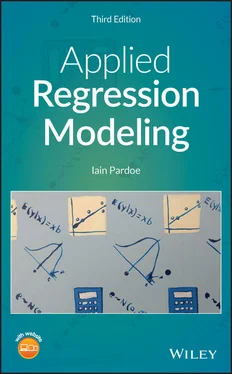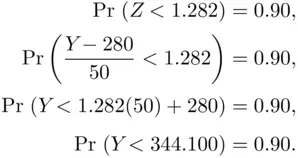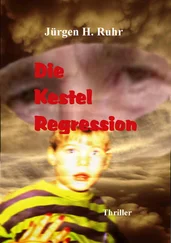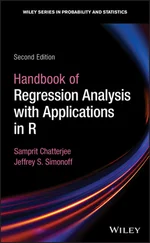Iain Pardoe - Applied Regression Modeling
Здесь есть возможность читать онлайн «Iain Pardoe - Applied Regression Modeling» — ознакомительный отрывок электронной книги совершенно бесплатно, а после прочтения отрывка купить полную версию. В некоторых случаях можно слушать аудио, скачать через торрент в формате fb2 и присутствует краткое содержание. Жанр: unrecognised, на английском языке. Описание произведения, (предисловие) а так же отзывы посетителей доступны на портале библиотеки ЛибКат.
- Название:Applied Regression Modeling
- Автор:
- Жанр:
- Год:неизвестен
- ISBN:нет данных
- Рейтинг книги:5 / 5. Голосов: 1
-
Избранное:Добавить в избранное
- Отзывы:
-
Ваша оценка:
Applied Regression Modeling: краткое содержание, описание и аннотация
Предлагаем к чтению аннотацию, описание, краткое содержание или предисловие (зависит от того, что написал сам автор книги «Applied Regression Modeling»). Если вы не нашли необходимую информацию о книге — напишите в комментариях, мы постараемся отыскать её.
delivers a concise but comprehensive treatment of the application of statistical regression analysis for those with little or no background in calculus. Accomplished instructor and author Dr. Iain Pardoe has reworked many of the more challenging topics, included learning outcomes and additional end-of-chapter exercises, and added coverage of several brand-new topics including multiple linear regression using matrices.
The methods described in the text are clearly illustrated with multi-format datasets available on the book's supplementary website. In addition to a fulsome explanation of foundational regression techniques, the book introduces modeling extensions that illustrate advanced regression strategies, including model building, logistic regression, Poisson regression, discrete choice models, multilevel models, Bayesian modeling, and time series forecasting. Illustrations, graphs, and computer software output appear throughout the book to assist readers in understanding and retaining the more complex content.
covers a wide variety of topics, like:
Simple linear regression models, including the least squares criterion, how to evaluate model fit, and estimation/prediction Multiple linear regression, including testing regression parameters, checking model assumptions graphically, and testing model assumptions numerically Regression model building, including predictor and response variable transformations, qualitative predictors, and regression pitfalls Three fully described case studies, including one each on home prices, vehicle fuel efficiency, and pharmaceutical patches Perfect for students of any undergraduate statistics course in which regression analysis is a main focus,
also belongs on the bookshelves of non-statistics graduate students, including MBAs, and for students of vocational, professional, and applied courses like data science and machine learning.


 is
is  (to the nearest
(to the nearest  ). This is much larger than the value we got above for the 90th percentile of the sampling distribution of
). This is much larger than the value we got above for the 90th percentile of the sampling distribution of  (
(  ). This is because the sampling distribution of
). This is because the sampling distribution of  is less spread out than the population distribution of
is less spread out than the population distribution of  —the standard deviations for our example are 9.129 for the former and 50 for the latter. Figure 1.5illustrates this point.
—the standard deviations for our example are 9.129 for the former and 50 for the latter. Figure 1.5illustrates this point.
 with mean
with mean  and standard deviation
and standard deviation  : the shaded area is
: the shaded area is  , which lies to the right of the
, which lies to the right of the  th percentile,
th percentile,  . The lower density curve (b) shows a normal sampling distribution for
. The lower density curve (b) shows a normal sampling distribution for  with mean
with mean  and standard deviation
and standard deviation  : the shaded area is also
: the shaded area is also  , which lies to the right of the
, which lies to the right of the  th percentile,
th percentile,  . It is not necessary for the population distribution of
. It is not necessary for the population distribution of  to be normal for the central limit theorem to work—we have used a normal population distribution here just for the sake of illustration.
to be normal for the central limit theorem to work—we have used a normal population distribution here just for the sake of illustration. is greater than 291.703? To answer this, consider the following calculation:
is greater than 291.703? To answer this, consider the following calculation:
 is greater than 291.703 is 0.10.
is greater than 291.703 is 0.10. . A generalization of the standard normal distribution called Student's t‐distribution solves this problem. The density curve for a t‐distribution looks very similar to a normal density curve, but the tails tend to be a little “thicker,” that is, t‐distributions are a little more spread out than the normal distribution. This “extra variability” is controlled by an integer number called the degrees of freedom . The smaller this number, the more spread out the t‐distribution density curve (conversely, the higher the degrees of freedom, the more like a normal density curve it looks).
. A generalization of the standard normal distribution called Student's t‐distribution solves this problem. The density curve for a t‐distribution looks very similar to a normal density curve, but the tails tend to be a little “thicker,” that is, t‐distributions are a little more spread out than the normal distribution. This “extra variability” is controlled by an integer number called the degrees of freedom . The smaller this number, the more spread out the t‐distribution density curve (conversely, the higher the degrees of freedom, the more like a normal density curve it looks). degrees of freedom.
degrees of freedom.
 . Since we will be using an estimate of the population standard deviation, we will be a little less certain about our probability calculations—this is why the t‐distribution needs to be a little more spread out than the normal distribution, to adjust for this extra uncertainty. This extra uncertainty will be of particular concern when we are not too sure if our sample standard deviation is a good estimate of the population standard deviation (i.e., in small samples). So, it makes sense that the degrees of freedom increases as the sample size increases. In this particular application, we will use the t‐distribution with
. Since we will be using an estimate of the population standard deviation, we will be a little less certain about our probability calculations—this is why the t‐distribution needs to be a little more spread out than the normal distribution, to adjust for this extra uncertainty. This extra uncertainty will be of particular concern when we are not too sure if our sample standard deviation is a good estimate of the population standard deviation (i.e., in small samples). So, it makes sense that the degrees of freedom increases as the sample size increases. In this particular application, we will use the t‐distribution with  degrees of freedom in place of a standard normal distribution in the following t‐version of the central limit theorem.
degrees of freedom in place of a standard normal distribution in the following t‐version of the central limit theorem.










